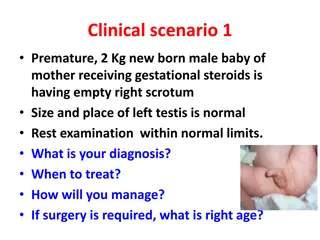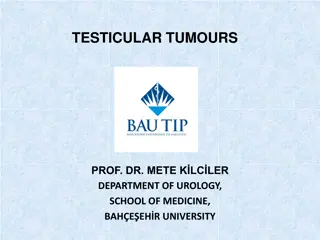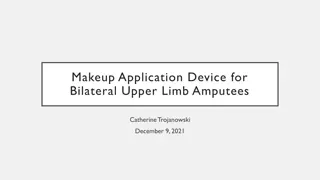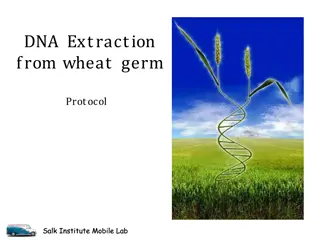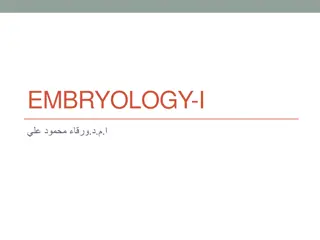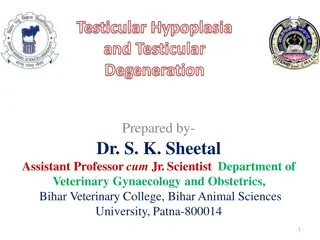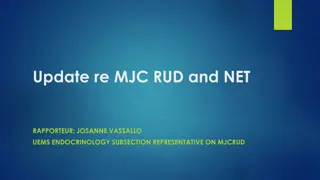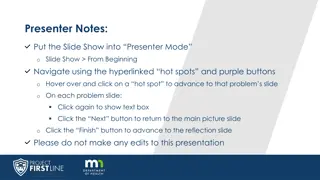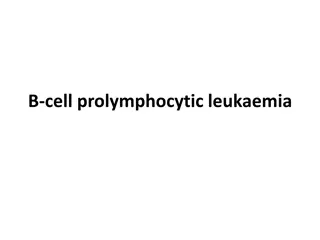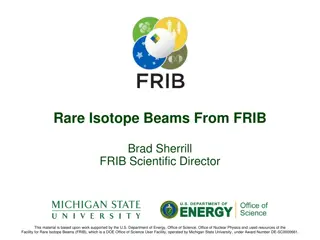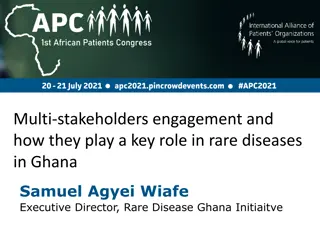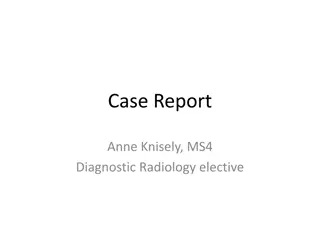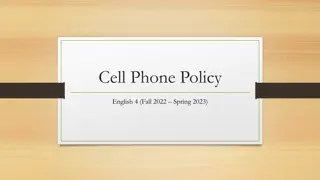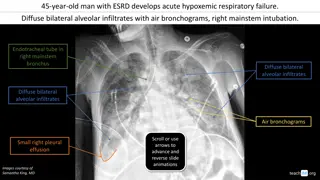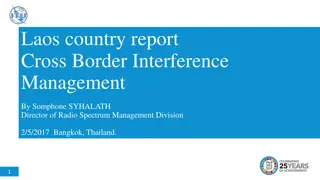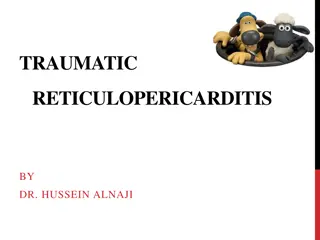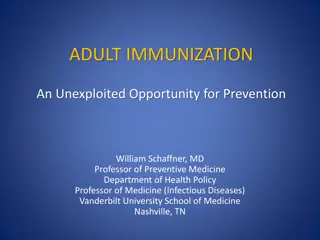Rare Case of Bilateral Undescended Testes with Intratubular Germ Cell Neoplasm in an Adult
A 35-year-old male presented with bilateral inguinal swelling and pain, revealing a rare case of synchronous bilateral intratubular germ cell neoplasm in bilateral undescended testes (cryptorchidism) in an adult. The pre-operative diagnosis was challenging due to the atypical tumor presentation. Risk factors for germ cell tumors include infertility, cryptorchidism, microcalcifications, and genetic predisposition. Examination and investigations confirmed the condition, leading to a probable diagnosis of bilateral undescended testes. Further imaging studies showed hyperdense lesions in the inguinal region with the likelihood of both testes located at the deep inguinal ring.
Download Presentation

Please find below an Image/Link to download the presentation.
The content on the website is provided AS IS for your information and personal use only. It may not be sold, licensed, or shared on other websites without obtaining consent from the author. Download presentation by click this link. If you encounter any issues during the download, it is possible that the publisher has removed the file from their server.
E N D
Presentation Transcript
INTRATUBULAR GERM CELL NEOPLASM INTRATUBULAR GERM CELL NEOPLASM (IGCN) IN BILATERAL UNDESCENDED (IGCN) IN BILATERAL UNDESCENDED TESTES (CRYPTORCHIDISM) IN AN ADULT TESTES (CRYPTORCHIDISM) IN AN ADULT Dr. Ashwini Panditrao Resident Department of surgery 1 1
INTRODUCTION Inguinal masses are a clinical enigma and always pose a dilemma for the surgeon. Pre-operative diagnosis is always difficult due to varied presentation of the tumours. The incidence of bilateral testicular germ cell tumour (BGCT) ranges between 1 and 5%. Synchronous bilateral germ cell tumour of the testis is rare and its association with bilateral cryptorchidism is even rarer. Risk factors for germ cell tumour are- 1. infertility, 2. cryptorchidism, 3. micro calcifications, and 4. genetic predisposition 2 2
CASE REPORT A 35yr old male patient Complaints of swelling in bilateral inguinal region since 6 months Pain in abdomen since 6 months No history of pain radiating to back No history of nausea and/or vomiting No history of altered bowel habits No history of weight loss No history of exposure General Examination- Pulse- 82/min Blood pressure- 130/80 mm of Hg No evidence of pallor, icterus, clubbing, oedema, lymphadenopathy, no supraclavicular lymphadenpathy 3 3
Local Examination- 1. Inspection- Oval swelling of approximately 3 2 cms in bilateral inguinal region Cough impulse was absent Skin over the swelling is normal No visible pulsations Bilateral scrotum empty 2. Palpation- Temperature normal Non tender 3 2 cms swelling in bilateral inguinal region Firm in consistency Smooth surface Skin over the swelling normal 4 4
Systemic Examination- 1. Per Abdomen-No lump Provisional Diagnosis- Bilateral Undescended Testes 5 5
INVESTIGATIONS Haemoglobin Total leukocyte count Liver function tests Blood urea Blood glucose level Renal function test Serum electrolytes Urine routine and microscopy Sperm count- azoospermia Beta HCG- 2.09 mIU/ml (normal range- 0-4mIU/ml) Alpha feto protein- 1.26 IU/ml (normal range- 0-8.5 ng/ml) LDH- 383 IU/L (normal range- 140-280 U/L) Within normal limit 6 6
Chest X-Ray- normal Ultrasonography abdomen normal study Ultrasonography inguinoscrotal region- Hyperdense lesion in right and left inguinal region with probability of both testes at deep inguinal ring. 7 7
CT scan pelvis- 1. 2 well defined hyperdense lesions noted in right and left inguinal region, right measuring 2 1.5 cm and left measuring 4 1.3 cm 2. Both lesions are located in the course of inguinal canal 3. No enhancement on contrast study, likely suggestive of undescended testes 8
MRI scan- 2 well defined lesions in bilateral inguinal regions adjacent to urinary bladder, measuring 2 1.5 cms and 2.4 1.3 cms, both located in the course of inguinal canal Impression- Bilateral Undescended Testes 9
OPERATIVE FINDINGS Patient was posted for high inguinal orchidectomy on both sides. 10 10
HPE of both sides revealed INTRATUBULAR GERM CELL NEOPLASM (pTis IGCN, Stage 0) 11 11
Post operative period uneventful During the last three monthly follow up, patient underwent 1. Clinical examination 2. Ultrasonography of abdomen Within normal limit 3. Estimation of tumour markers 4. CT scan abdomen and pelvis- no retroperitoneal, pre- and para- aortic lymphadenopathy 12 12
DESCENT OF TESTES (During 7th week of fetal development) (At 3 months of gestation at internal inguinal ring) (Begins between 7 and 9 months of gestation and completes by birth) 13
DISCUSSION Terms such as undescended testis, retentio testis, cryptorchidism, and maldescended testis describe a testis that is not normally located at the bottom of the scrotum. Undescended testis may be situated along its normal route of descent or in an ectopic position. Cryptorchid/ undescended testis neither resides nor can be manipulated into the scrotum. 15 15
Ectopic testis is the one that has an aberrant course of descent, usually after leaving the inguinal canal, femoral, pubopenile, perineal or crossed scrotal. Retractile testis can be manipulated into the scrotum where it remains without tension. Gliding testis can be manipulated into the upper scrotum but retracts when released. Acquired is the one in which testis previously descended or after orchiopexy or other inguinal surgery (hernia), then ascends spontaneously. 16 16
ETIOLOGY OF UNDESCENDED TESTES The aetiology of cryptorchidism remains largely unknown. Several risk factors like- 1. Intrauterine growth restriction (IUGR) 2. Prematurity- incidence in premature infants 30% 3. First- or second- born boys 4. Perinatal asphyxia 5. Toxaemia of pregnancy 17 17
The incidence of bilateral germ cell tumour (BGCT) is much greater in younger age group than compared to that of unilateral seminoma which is common in patients older than 30yrs of age. Testicular intratubular germ cell neoplasia as seen in our case is considered a premalignant lesion for development of germ cell tumours. Incidence of intratubular germ cell neoplasia (IGCN) is high in patients with one or more risk factors (35-85%) and its detection allows curative tumour eradication with minimal morbidity or mortality. Primary bilateral testicular tumour is rare ,its prevalence ranges from 2.5% to 5%, most tumours being metachronous. 18 18
In a study by Tekin et al.of 552 patients with GCTT,11 patients developed bilateral disease. Out of 11 patients, 7 developed a second tumour metachronously and 4 had synchronous bilateral GCTT. The incidence of bilateral germ cell tumours was 1.8% (14 of 776 patients) in patients with seminoma and 0.6% (10 of 1655 patients) in patients with non seminomatous germ cell tumours. Cryptorchidism, infertility, or atrophic testis was associated with development of bilateral GCTT in 7 of the 11 patients. All synchronous tumours and most of the sequential tumours had identical histology on both sides. 19 19
Post orchidectomy management of these patients has been dictated by the stage of the tumour in either of the testes and the pathology with the higher malignant potential (NSGCT as compared to pure seminoma). Bilateral seminomas have a higher tumour burden, therefore, these patients should not be kept on surveillance only; rather should be treated with prophylactic para-aortic lymph node irradiation or one to two cycles of adjuvant chemotherapy. Patients in stage II or higher should be treated with chemotherapy. 20 20
CONCLUSION Clinical examination and a simple imaging modality like USG are gold standard in earlier diagnosis of the condition. Thus a thorough clinical and radiological evaluation is of paramount importance in patients being investigated for infertility. Bilateral testicular tumours with cryptorchidism are extremely rare and amongst them, synchronous bilateral testicular tumours are even rarer. Adjuvant therapy in the form of cisplatin-based chemotherapy has markedly increased the survival rate. Prognosis depends upon the clinical staging and not whether it is unilateral or bilateral involvement. Our patient will require life long follow up and androgen replacement. 21 21
WHAT MAKES OUR CASE UNIQUE Incidence of bilateral testicular tumours with cryptorchidism is extremely rare and among them, synchronous tumours are even rarer which was in our case, less than 0.8%. Option of testes sparing surgery can be given to patients who are aware and accept the risk of subsequent local relapse and realize the importance of compliance and follow up. 22
REFERENCES 1. Sushma Agrawal, Ranjeet Bajpai, R. K. Agrawal and T. C. Gupta. Bilateral synchronous seminoma with bilateral cryptorchidism of the testis. Indian J Urol.2010; 26(4):587 589 2. Walid K. Adham, Bharat K. Raval, Maria C. Uzquiano and Luciano B. Lemos., Bilateral Testicular Tumors: Seminoma and Mixed Germ Cell Tumor. Jrnl of RadioGraphics. 2005; 25:835-839. 3. Coogan CL, Foster RS, Simmons GR, Tognoni PG, Roth BJ, Donohue JP. Bilateral testicular tumors: management and outcome in 21 patients. Cancer. 1998; 83(3):547-52. 4. Che M, Tamboli P, Ro JY, Park DS, Ro JS, Amato RJ, Ayala AG. Bilateral testicular germ cell tumors: Twenty-year experience at M. D. Anderson Cancer Center. Br J Cancer. 2002; 95(6):1228-33. 23
5. Garca Mora A, Gutirrez Garca JD, Ortiz Lara Gerardo E, Mart nez Montelongo R, G mez Guerra Lauro S. Synchronous bilateral testicular seminoma in an adult patient with bilateral cryptorchidism: A case report and literature review.Actas Urol Esp.2010;34(2):210-1. 6. Tekin A, Aygun YC, Aki FT, Ozen H. Bilateral germ cell cancer of the testis: A report of 11 patients with a long-term follow-up. BJU Int. 2000; 85(7):864-8. 7. G czi L, Gomez F, Bak M, Bodrogi I. The incidence, prognosis, clinical and histological characteristics, treatment, and outcome of patients with bilateral germ cell testicular cancer in Hungary. J Cancer Res Clin Oncol. 2003; 129(5):309-15. 8. HolzbeierleinJM, Sogani PC, Sheinfeld J. Histology and clinical outcomes in patients with bilateral testicular germ cell tumors: the Memorial Sloan Kettering Cancer Center experience 1950 to 2001. J Urol.2003; 169(6):2122-5. 24
THANK YOU 25


